Managing application programming interfaces (APIs) is a vital part of any software development lifecycle. The reason is that APIs are a primary way of communicating among different pieces of software. And to ensure your solution works efficiently and smoothly, you need to thoughtfully build, integrate, and maintain all of your APIs.
However, managing API is tricky. Apart from building secure and efficient application programming interfaces, your team also needs to have a clear strategy for auditing, maintaining, and updating all the APIs. Without such a thoughtful plan, a rush to build APIs can lead to poor product maintenance and limited performance.
In this article, we discuss the significance of API management and the main strategies to be aware of. We also tackle API management tools and platforms, mentioning key success metrics to keep in mind when assessing your API management efforts.
This article will be helpful for API providers who want to securely expose, monitor, and optimize APIs, facilitating seamless integration with external partners. It may also come in handy for engineers who manage complex IT environments and want to maintain control, security, and reliability over an API ecosystem.
Contents:
What is API management and why is it important?
Application programming interface (API) management is the process of creating, deploying, managing, analyzing, and improving APIs.
API management involves analyzing, controlling, and distributing the APIs that connect software to external applications, either on-premises or in the cloud. Organizations often create their own APIs to connect different pieces of in-house software. Using APIs, you can connect infrastructure inside your organization or pair in-house software with third-party software. Either way, API management means controlling all the APIs used by particular software, taking care of their security, usage, and lifecycles.
One of the key nuances in API management is choosing the right vendor for your API management tools and platforms. Some organizations choose to create their own tools and platforms, but most look for vendors that offer API management tools or platforms that match their needs and strategies. Later in this article, we discuss such tools and platforms in detail.
The structure of API management platforms can vary, but the most important components usually are:
- Gateways — handle API requests to user or client devices
- Lifecycle management — helps an organization manage API states during the entire lifecycle: design, development, testing, deployment, and maintenance
- Developer portal — helps developers deploy and manage their APIs
- API analytics — displays different operational and business metrics that provide an organization with insights on API performance
Modern application programming interfaces are less dependent on service-oriented architectures (SOAs) thanks to the open API movement. Application programming interfaces now use services like JSON or REST. Some tools and platforms can turn SOAP, MQ, or JMS interfaces into RESTful APIs and JSON content.
Knowing the basic technical aspects, let’s move to practical details and benefits of API management.
What exactly can you use API management for? Below, we briefly overview a few common examples:
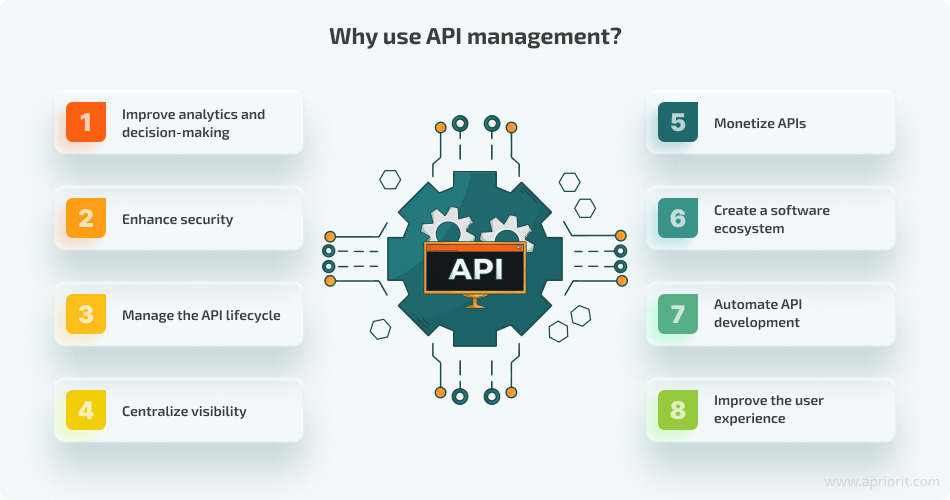
1. Improve analytics and decision-making
If you’re an API provider, analytics will show you how customers use your APIs. For instance, your developers can see the frequency of requests, detect which requests fail and how often, and track how many apps use your APIs and for what purposes. This will help you identify popular services, improve your interfaces, and decide which APIs to develop next.
2. Enhance security
APIs expose an organization’s data, which is why it’s important to pay attention to the security of your APIs. Certain tools can help with this. With API management solutions, you can create different levels of access for users and thus protect data from unauthorized access. An API management system also helps you see what modern security protocols are used.
3. Manage the API lifecycle
An API management tool or platform will help you design, implement, maintain, and even retire your interface. Thus, your team can easily control and support all APIs during their whole lifecycle, timely detecting and fixing issues.
4. Centralize visibility
This feature will help you see all your application programming interfaces in one place and avoid redundancy. It will also allow your developers to see issues they haven’t yet addressed and make it easier to plan further development.
5. Monetize APIs
You can create an additional revenue stream by monetizing your application programming interfaces. An API management tool can help you with billing, tracking usage, and sharing revenue with your partners.
6. Create a software ecosystem
API management tools can help your team connect internal and external products into a single ecosystem for efficient communication and automation.
7. Automate API development
With dedicated management tools and platforms, your developers can save much time building interfaces by leveraging API templating and automated API creation features. Such functionality can eliminate redundant work, accelerate deployment, avoid APIs with duplicated purposes, and follow Agile methodologies without sacrificing quality or security.
8. Improve the user experienceBy using API management solutions, your team will have more time to ensure top-notch quality, functional design, and well-written documentation and guidelines for your solution. Thus, it will be easier and more enjoyable for your clients to use your APIs.
Looking for skilled API developers?
Apriorit engineers will enhance your solution with the required functionality, keeping your software secure and efficient.
Three strategies for API management
The way to implement and run API management depends on your business goals. Let’s overview the three most common strategies.
1. API integration
Application programming interfaces are basically gateways through which pieces of software talk to each other and exchange information. Integrating them means connecting applications through interfaces and allowing those applications to perform planned functions. The right API management approach can help you modernize legacy enterprise systems and optimize your software.
Application programming interfaces help applications exchange data and work properly without having to worry about compatibility and versioning. To integrate two applications through APIs, you’ll need an API management system.
The complexity of your third-party API integration will depend on the particular solution. Some tools make it easy thanks to pre-installed integrations, providing mapping between applications and not requiring complex actions. However, if you need to integrate two enterprise applications, this will require coding expertise and the use of complex libraries and tools.
2. B2B integration
When two or more businesses need to automate their operations and communicate effectively, they can use interfaces to exchange information and coordinate processes. B2B integrations are used to connect businesses to customers, suppliers, partners, and other entities.
B2B integrations can help businesses transition from paperwork to digital document management or to automate supply chains. To make that work, a B2B integration securely moves information from an internal source to an external application through API management software.
3. DaaS
Data as a service (DaaS) allows businesses to access data storage, integration, processing, analytics, and other cloud services via APIs. This makes data processing and management easier and more flexible. However, for some businesses, DaaS may not be functional enough because of security limitations. These limitations can be overcome, for example, by data encryption.
Successful applications of API management
The use cases for API management are numerous. For instance, this approach can help you support digital transformation strategies, meet many GDPR requirements for data privacy, and encrypt sensitive data.
To better understand how API management works, let’s observe examples of its real-life applications. Below, we explore two cases from domains in which Apriorit has hands-on expertise.
1. FinTech: Wells Fargo
Wells Fargo is a large US bank that wanted to create an omnichannel experience for their users. For this, they needed to build a banking platform that would connect to their existing services via APIs.
The Wells Fargo Gateway unites user experiences on any platform, whether mobile or web. Wells Fargo used APIs to connect all their digital products into a single database, which helped them automatically update information on all platforms. For example, if a user performs an action on a mobile device, it will immediately be shown on the desktop version of the Wells Fargo website.
2. Ecommerce: New York & Company
New York & Company is a world-famous retailer that needed to connect their brick-and-mortar and online stores into a single system that would provide users with a seamless omnichannel experience.
To connect their web and mobile ecommerce stores and gather real-time inventory data, New York & Company used the MuleSoft API management platform. With the help of application programming interfaces, they connected their web and mobile software to a shared database and integrated payment gateways that allow users to pay for products.
This approach allowed New York & Company to take third place in the 2017 BusinessWire list of best omnichannel retailers.
Related project
Developing Drivers for Low Latency Virtual Reality Headsets
Discover how we developed a VR headset driver for our client while they were still working on the hardware. We reveal details of building a high-speed data transmission protocol, a Windows device driver, and an API for this driver.

API management tools vs API management platforms
A significant part of your API management strategy is wisely choosing your technology stack. The market is full of solutions, from small tools to large platforms, that simplify API development and maintenance. Let’s figure out what the main differences are between the two main types of API management software and which you should choose.
There’s a wide variety of API management tools and platforms for any type of business:
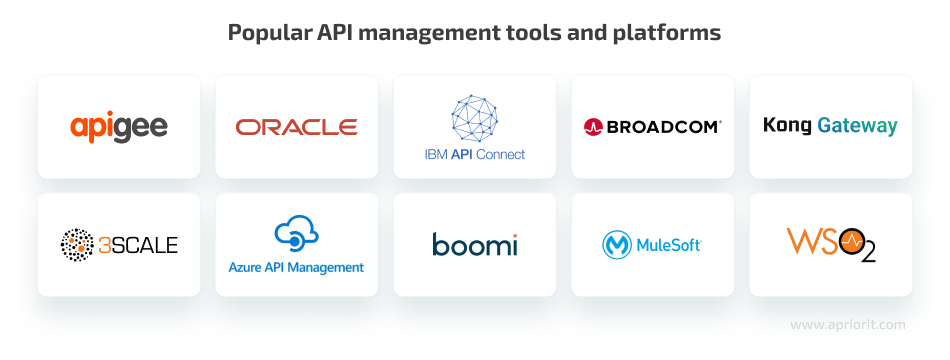
Each API management tool has its own unique feature set, but such tools typically offer a combination of these functionalities:
- Documentation tools
- Security tools
- Sandbox environments
- Backwards compatibility
- API connection automation
- Version control
- Traffic monitoring
- Memory management and caching
- Load balancing and fault tolerance
You can build tools on your own if you want to keep all your data and be responsible for its safety. But many organizations go for third-party solutions they can purchase as a service and choose the best API management software for their goals.
Some organizations manage to create their own ecosystems of API management tools, cherry-picking the features they need from existing tools. If you feel that stitching together different tools will make your work process too complicated, you should consider moving to an enterprise API management platform.
An API management platform usually combines everything enterprise software might need and offers a standardized process for creating, managing, and deploying APIs. This helps you organize your API management processes.
An API management platform also acts like a proxy and protects your backend services from downtime due to excessive requests from customers, partners, or internal users.
One of the best parts of API management platforms is analytics, which is usually included in the feature set. Analytics allows you to see who uses your APIs and how, and this knowledge makes it easier to manage your developer community, plan further development, and improve your interfaces based on data.
Platforms also usually have developer portals that make it easy to distribute and acquire APIs.
Let’s now review the most popular API management platforms you can use to organize and improve your application programming interfaces.
Top three API management platforms
There are a large number of platforms to choose from as the API management solutions market keeps growing. The best way to choose is to compare platform capabilities to your needs. Make sure that your choice covers all of your needs, whether you’re a small startup or an enterprise.
Here are the three most popular platforms you can use for enterprise API management.
1. Google Apigee API management platform
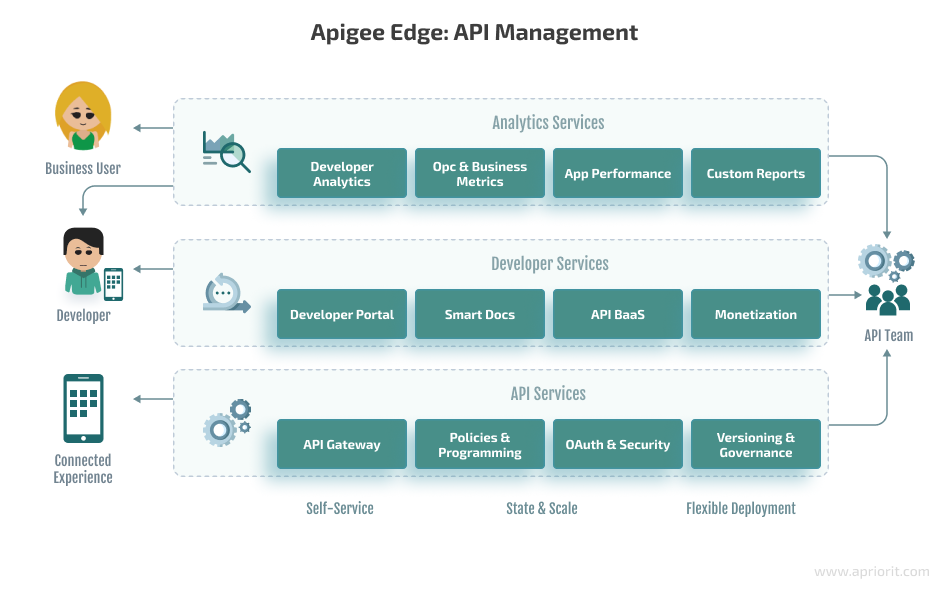
The Apigee platform from Google allows you to design, develop, secure, and manage your APIs in a single environment. With Apigee, you can develop your own API proxies and use code to customize application programming interface policies according to your API flow.
Google cloud API management tools have extensive security features, allowing you to enforce different protocols including OAuth 2.0, SAML, two-way TLS, and various encryption protocols across all your APIs.
Apigee Edge is an additional tool that can help you manage microservices as APIs. Other features of Apigee Edge include:
- API publishing
- API analytics
- API monitoring
- API monetization
- Developer portal
2. MuleSoft Anypoint Platform
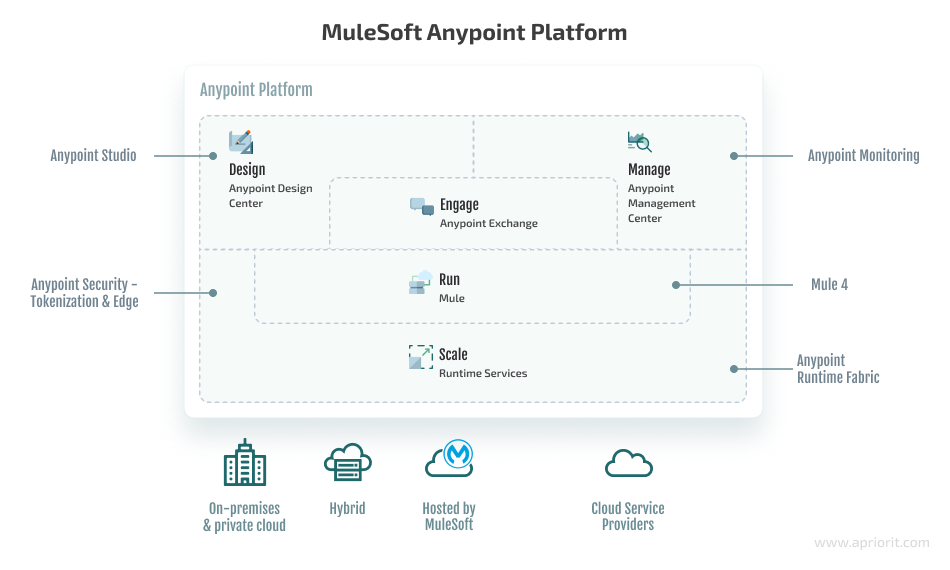
The MuleSoft Anypoint Platform is a great solution for enterprises. It offers a guided web interface for API development and automatically creates documentation from API specifications. A mock service allows developers to gather feedback before an API is implemented.
MuleSoft can transform data between many data formats — for example, between XML and JSON. Just as other large enterprise API platforms do, MuleSoft allows developers to deploy, design, protect, manage, and reuse their APIs.
All of these services support cloud-based API management as well as on-premises management or a hybrid approach.
Deploying and testing APIs with MuleSoft is easy, as it allows you to plug integrations into CI/CD pipelines with support for Maven and Jenkins.
3. WSO2
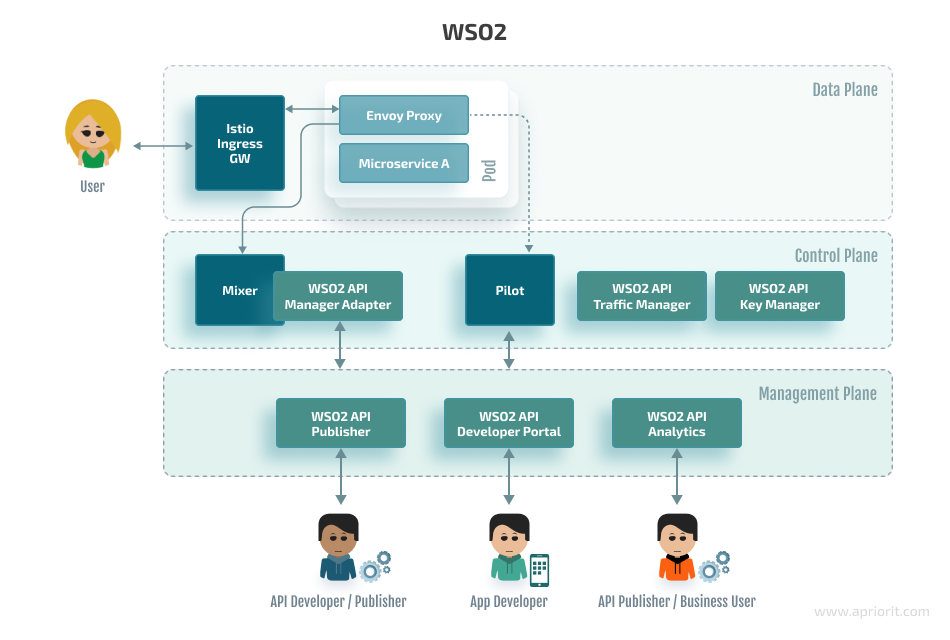
WSO2 is a fully open-source API management and integration platform that you can use in the cloud, on-premises, or in a hybrid environment. It provides full-cycle management and monetization. WSO2 offers specific products to companies in the healthcare and finance industries, so if you’re a healthcare organization or a FinTech product founder, WSO2 might be the best option for you.
WSO2 is a great fit for both monolithic and microservices architectures. It also offers advanced analytics for tracking how developers use your APIs.
Read also
How to Test REST API Services on the .NET Platform
Since the API layer is an essential software component, thorough API testing is a must. Explore an example of REST API testing in our article.

API management success metrics
Before picking an API management platform or tools, it’s essential to first define metrics, then analyze the performance of available options. Let’s see what characteristics to observe to ensure truly successful API management.
1. Dependability. This metric refers to the availability of your APIs to developers for a certain number of API calls within a certain timeframe. Quotas protect APIs from being overloaded and make them easier to manage. Many API providers base their pricing on quotas.
2. Flexibility. This refers to the number of options developers have when they adopt APIs. The more flexible your APIs, the more development and management they require.
3. Quality. Quality is measured mostly by developer satisfaction. If developers use your APIs, don’t come across any serious problems, and feel their expectations are met, this means your APIs are high-quality.
4. Speed. You can increase responsiveness by throttling and caching. These techniques will allow you to improve access latency and throughput.
Apriorit’s API management expertise
At Apriorit, we know how important it is to ensure a smooth and secure data flow. We develop and integrate high-quality APIs that establish proper software performance and enrich products with required features and functionality. We create APIs for different purposes and goals like data exchange, synchronization, verification, payment processing, and user authentication.
Apart from that, Apriorit’s engineers focus on keeping your APIs well-managed. We help businesses:
- Review and update old APIs
- Support legacy code
- Keep all APIs optimized and cost-efficient
- Ensure scalability to help products meet increased demand
- Bulletproof APIs with security testing, HTTPS encryption, and more
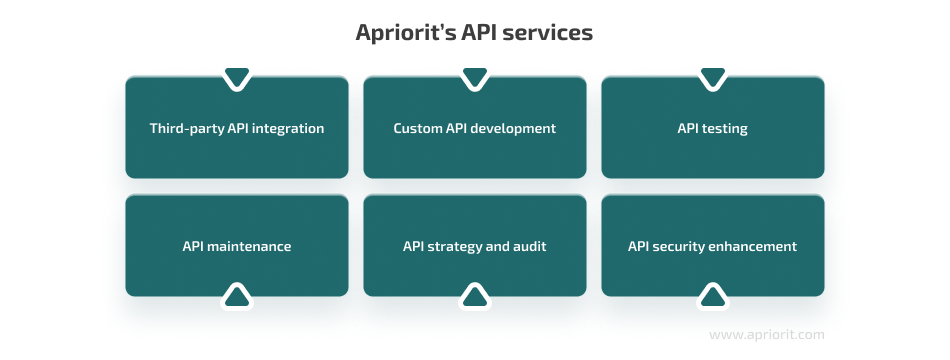
We’re ready to help you with API management to:
- Develop solutions fast and cost-effectively
- Enrich your software with various functionalities
- Ensure smooth connection with other apps, systems, and devices
Apriorit also has vast experience developing custom application programming interfaces when:
- There’s no off-the-shelf API for your target service
- Available APIs don’t fit your solutions
- You want to share your product’s capabilities and data
Continuous improvement is also a vital part of the API lifecycle. To learn more about overcoming API overloading and scaling a highly loaded API that processes resource-intensive requests, check out our article on how we scaled API performance in a high-load system and avoided CPU overload.
Conclusion
Application programming interfaces are currently the most widely used way to integrate services into software and connect different apps inside an organization. Some companies create APIs to monetize them; others use them to build internal ecosystems for end users or employees.
In all of these cases, API management is required. API management platforms and tools help developers and businesses create convenient API infrastructures, protect APIs from hackers, monetize them, and get insights on how they’re used by developers.
If you want to build an omnichannel experience, integrate services into your software, and create an ecosystem of products for your customers or internal operations, feel free to contact us. Our experienced API developers will gladly help you build reliable application programming interfaces for any kind of integration and efficiently manage all of your APIs.
Want to improve your API management?
Improve the performance of your software or business processes with the right API management strategy. Apriorit’s engineers are ready to audit, update, and maintain your application programming interfaces. We’ll also gladly create new APIs with top-notch quality and security.


